A field of freshly baled hay is a sure sign that warm weather has arrived. The first baling of the season is generally in mid-May in the southern United States and late May in more northerly regions. If you don’t live on a farm, you may have some questions about those seasonal hay bales that appear in pastures in the late spring and throughout the summer. For example, how much does a bale of hay weigh? We’ve got the answer, plus all kinds of other hay information for you.
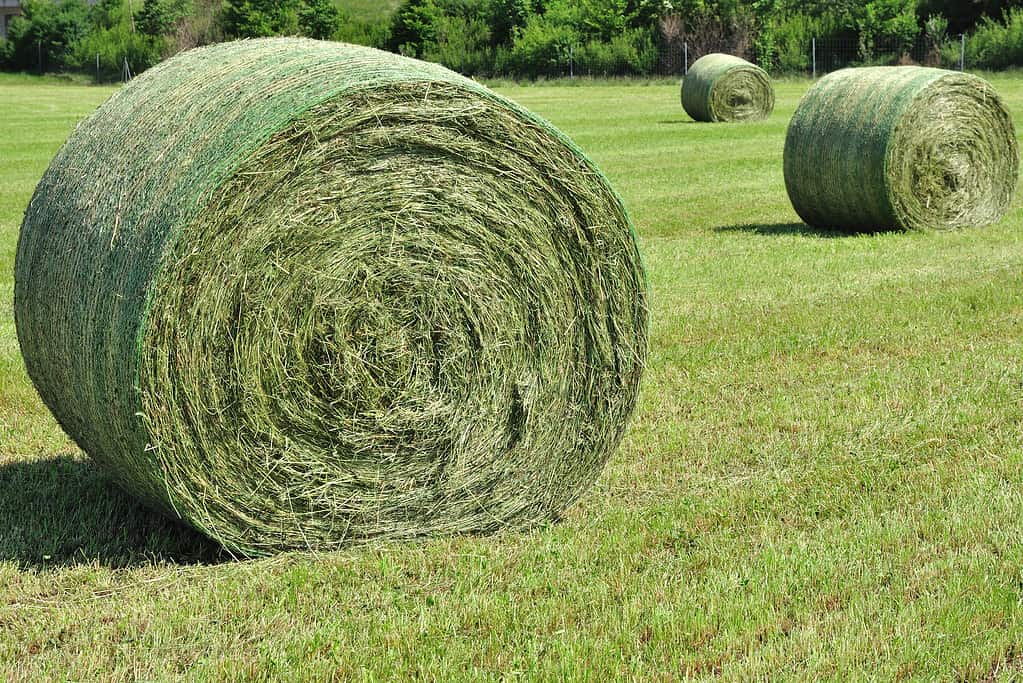
Freshly baled hay is a common sight in farm pastures beginning in May.
©klamor/Shutterstock.com
How Much Does a Bale of Hay Weigh?
The short answer is, it depends. The weight of a hay bale is determined by the type of hay (more on that momentarily), the moisture content (hay loses moisture as it ages, so new hay bales weigh more than older ones), and the type of bale. Here are the typical dimension and weight ranges for different bale types.
Two-String Square Bales
These small bales typically measure 14 inches high, 18 inches wide, and 35” long. They weigh 40-75 pounds.
Three-String Square Bales
These mid-size bales usually measure 16 inches high, 22 inches wide, and 44 inches long. They weigh from 100-140 pounds.
Round Bales
The typical width of a round bale is four to five feet, with a diameter of five to six feet. These are easily the largest of the three main types of hay bales, weighing 550-1,600 pounds.
What Is Hay?
Hay is a plant that has been cut, dried, and stored as feed for ruminant animals. It is typically fed to livestock during the winter or periods of drought when grasses wither and are nutrient-poor.
Hay vs. Straw
People often conflate hay and straw, but they are actually two very different things. It is similar to how llamas and alpacas are often confused. The animals are related, but they are definitely not the same. A rancher who raises alpacas can quickly tell you how they differ from llamas. In the same way, any farmer who grows hay can quickly spell out the differences between hay and straw.
Hay and straw are both made from plants. Both are cut and baled into either square or round bales. But that is where the hay/straw similarities end.
Hay
Hay is a food source for livestock. It is made from the entire plant: stems, flowers, leaves, and immature seeds. Using the whole plant gives hay a much higher nutritional value for the animals. It is not a perfect analogy, but this is somewhat similar to how whole grain is more nutritious for humans. Whole grain contains the endosperm, germ, and bran. Refined grain retains only the endosperm, making it less nutritious than whole grain.
Straw
While hay uses the whole plant, straw is a remnant that is left after the seeds of a plant have been harvested. When wheat, oats, barley, or other grain is harvested, the seeds are collected while the stalks are left behind. Nearly all of the plants’ nutrients were funneled to the seeds, meaning the stalks have little, if any, remaining nutritional value. These stalks would be virtually useless for animal feed. However, the stalks can be used for animal bedding. This is known as straw.
Straw bedding gives animals a soft place to lie down. It also absorbs moisture from manure and makes it easier to keep stall areas clean. Small amounts of high-quality straw can sometimes be mixed with hay to stretch the feed supply, especially when hay prices are high, or quantities are low. Straw may add a bit of roughage to the feed, but it adds virtually no nutrients.
To the uninitiated, hay and straw may seem to be two sides of the same coin. In reality, they are very different products with very different uses.
By the way, it may interest you to know that you’ve probably never been on an actual hayride. These wagon rides are popular fall activities, alongside bonfires and hot apple cider. However, riders don’t sit on hay bales onboard the wagon. The seats are actually straw bales. Hay is far too valuable to be used as wagon seats, so straw bales are used instead. From now on, when you go on that autumn hayride, you’ll know that it is actually a straw-ride.

Straw is most-often used for livestock bedding, as seen with these sheep.
©Vladimir Mulder/Shutterstock.com
Hay vs. Silage
There is also a difference between hay and silage. Silage is pasture grass that has been preserved by acidification (the result of fermentation in the absence of oxygen). Essentially, silage is a form of “pickled” pasture grass.
The biggest difference between hay and silage is the moisture content. Hay usually has a 10-15% moisture content, while silage has a 40-60% moisture content. Silage is kept in airtight conditions, such as plastic wrap, that prevents it from molding.
Producing silage is more difficult and involved than producing hay, but hay loses nutrients as it dries. Silage retains much of this nutrition since it doesn’t dry out.

Wrapping bales in airtight plastic produces silage, a fermented or “pickled” hay.
©Veltman34/Shutterstock.com
Bale Types
As mentioned above, there are two main types of hay bales: square bales and round bales. The sizes of each can vary, but those are the two basic options for hay baling.
There are no notable differences in hay quality or nutrition between round and square bales. The differences are mainly found in the work required to handle and transport them.
Square bales are smaller, but they are far more labor-intensive. Square bales must be loaded onto a trailer and then stacked in a barn or other storage facility by hand. It is a sweaty and difficult job.
Round bales can contain more than 20 times the hay square bales. These huge bales that weigh more than 1,000 pounds are usually moved with a tractor or skid steer. A spear is affixed to the front of the tractor. That spear is pushed through the center of the round bale. It is then lifted off the ground and transported to a trailer or barn. While loading and transporting square bales requires a team of people, moving round bales is a one-person job.
Round bales are the most common hay bales on farms around the world today because of the ease and speed of production and transport.
There is still a market for square bales, though. Square hay bales are advantageous for smaller farms with fewer animals. Square balers are also about half the cost of round balers. With the explosion of hobby farms, the demand for square bales has actually increased in recent years.
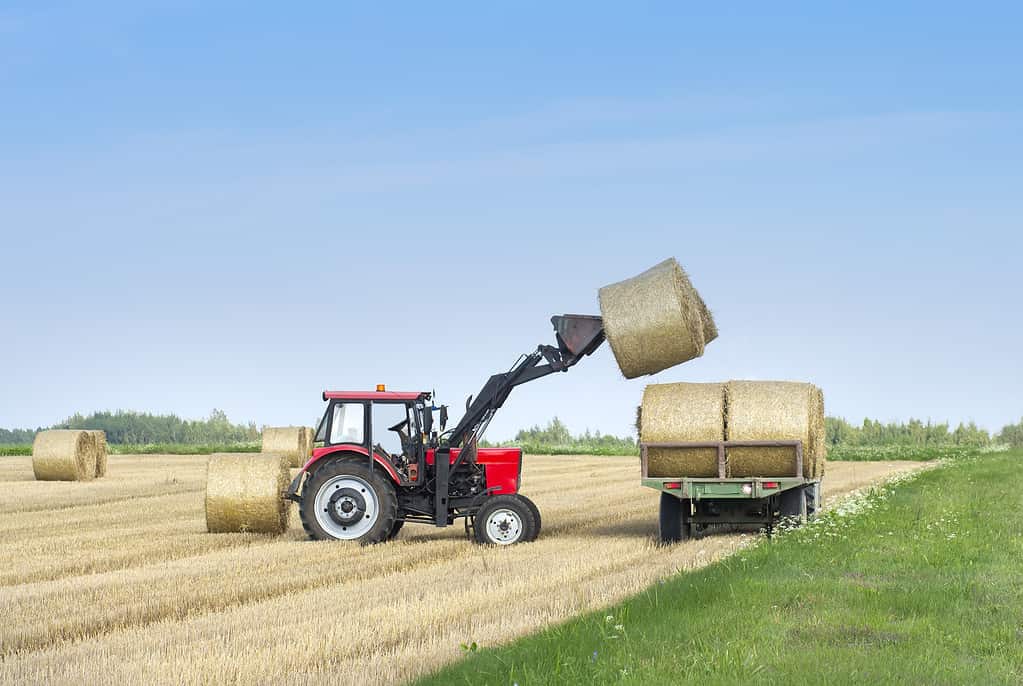
After baling, round bales are speared and then lifted onto a trailer.
©iStock.com/Dzmitrock87
Baling Process
Mowing
Hay should be mowed when it is at its nutritional height. Waiting too long, such as after the seed heads for grass hay, significantly decreases its nutritional value. Farmers can often get 2-3 cuttings off of a single field each year.
Raking
Once the hay is mowed, it is left in the field to dry. After some drying time, the hay is raked. Normally hay is mowed in the morning and left to dry for the remainder of the day. It is raked the following day. The hay is raked into windrows and is typically left to continue drying until the next day.

Hay is raked into windrows before baling.
©iStock.com/FOTO-UP
Baling
On the third day, assuming weather conditions are cooperating, the hay is typically ready to be baled. After baling, the hay is transported to the storage area.
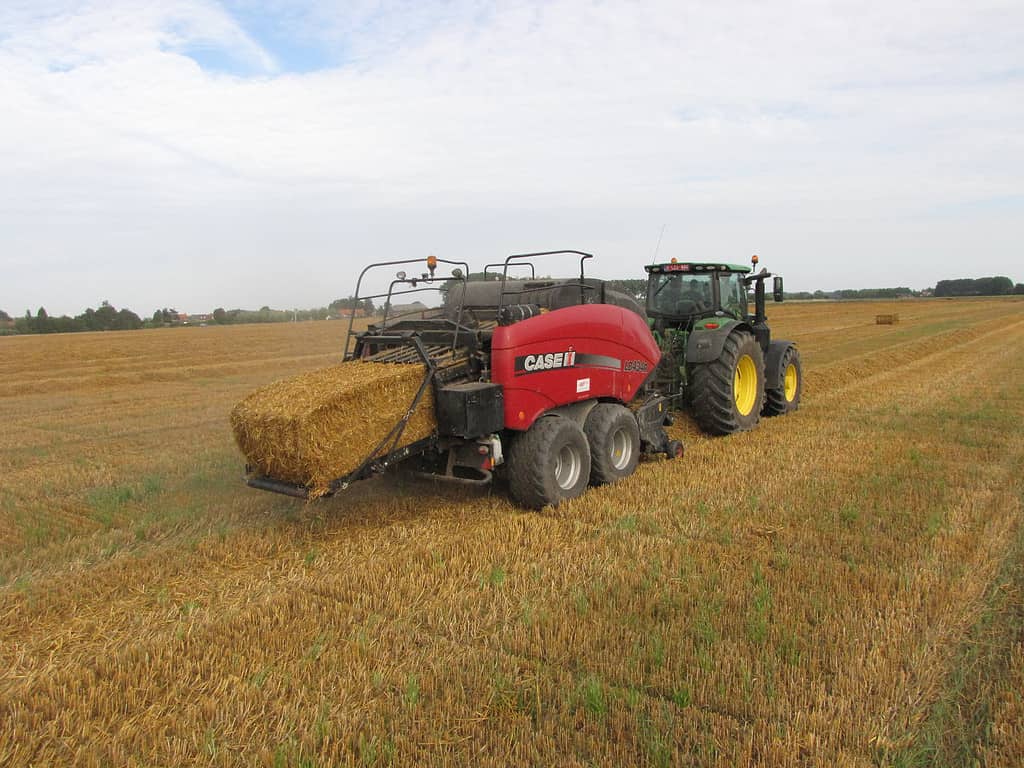
While round bales are the most popular by far, some farmers still use square bales, as seen in this square bale of straw.
©iStock.com/Angelique Nijssen
Types of Hay
There are two main types of hay: legume hay and grass hay. Legume hay bales are typically denser and heavier than grass hay bales.
Legume hay in the U.S. is usually comprised of alfalfa and clover. Grass hays often include timothy, rye, fescue, and orchard grasses.
Legumes generally have a higher protein and calcium content than grasses. Legume hay also typically contains more vitamins and minerals than grass hay. On the other hand, grass hay has a higher fiber content than legume hay.
Due to the distinct advantages of both hays, farmers and ranchers will often choose to feed a mixture of both to their livestock. It depends on the circumstances and the specific animal, though. Horses may gain too much weight with a diet of legume hay. Dairy cows, however, produce more high-quality milk when fed mainly legume hay.
There is a third type of hay that is a relative newcomer to the livestock feed scene: grain hay. Grain hays are typically made from oat, wheat, and barley. These hays are not nearly as widespread as legume and grass hays, but they are gaining popularity.
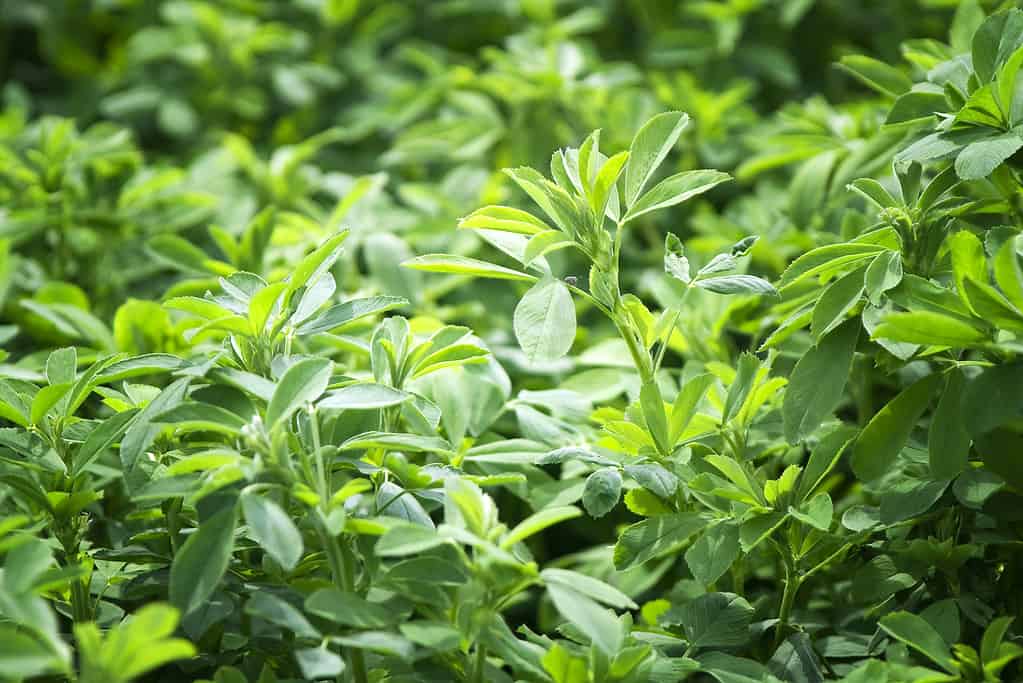
Alfalfa is an important, nutrient-dense forage plant.
©iStock.com/ivandzyuba
Animals That Eat Hay
Hay is a dietary staple for all manner of domesticated animals. Cattle, horses, donkeys, goats, sheep, alpacas, and llamas all eat hay. Even pigs, chickens, and ducks can feed on hay, though it should only be offered sparingly.
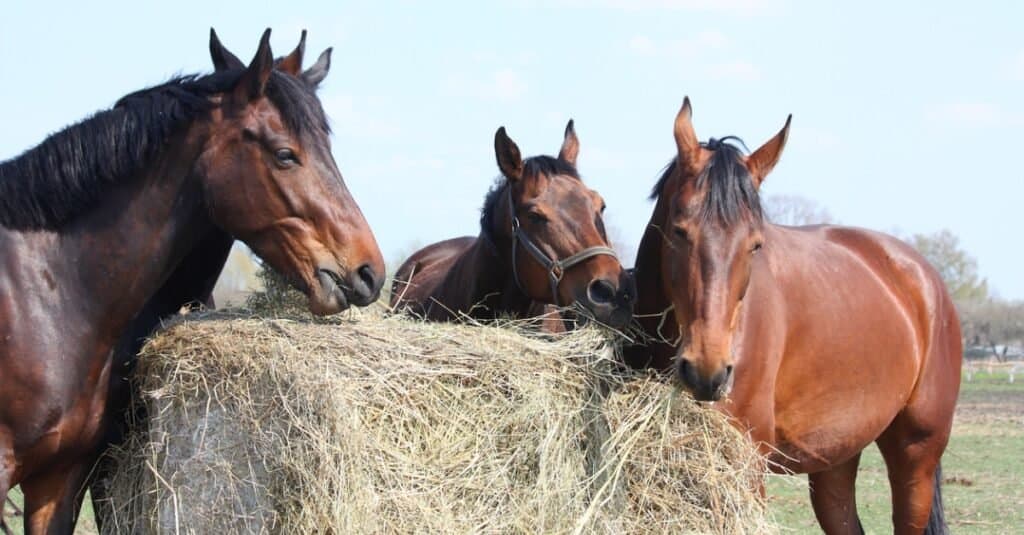
Hay is a critical food source for horses.
©iStock.com/virgonira
Hay can also be part of the feeding plan for small animals, although some require grass hay and some fare better with legume hay. Rabbits, guinea pigs, chinchillas, tortoises, and turtles all eat hay. Hay is not the mainstay of their diets, but it can certainly be included.
Even zoos make use of hay. Rhinos, giraffes, and elephants in captivity often munch on hay. Other exotic animals such as camels, zebras, okapis, gazelles, and many other herbivores can also eat hay.
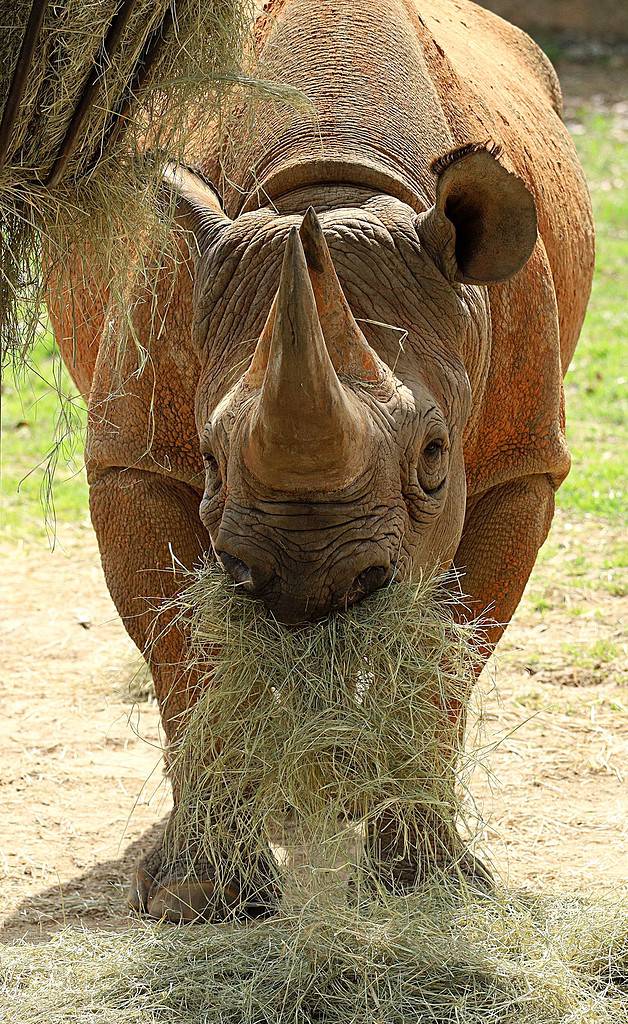
Zoos rely on hay to feed many animals, including rhinos.
©Lilly P. Green/Shutterstock.com
Value of Hay
Hay is crucial to the overall U.S. agricultural economy. Because livestock must continue to thrive in winter and other times when pastures are not producing, hay is among the top-ten largest sources of cash receipts among U.S.-produced farm commodities according to the USDA Economic Research Service.
History of Hay Production
Farmers have had to find ways to feed their animals for as long as there has been domesticated livestock. At one time, that meant allowing animals to forage in forests and wherever else native grass could be found. However, when winter came, and this free-range foraging wasn’t an option, animals often died from starvation.
Hay Production by Hand
In colonial America, red clover, white clover, and timothy grass were imported from Europe. Alfalfa was also introduced to American pastures from central Asia. However, harvesting this hay was a difficult, laborious process that was done completely by hand. The plants were cut with a scythe or sickle and then raked with a wooden rake or fork. For most of the eighteenth century, hay production was low due to the time-consuming and back-breaking labor that haying required.
Technological Innovations
The nineteenth century brought many innovations to the American farm, including huge advances in hay production. The first horse-drawn hayrake was introduced in the early 1800s. This was revolutionary because, for the first time in history, hay production was not completely done by hand.
With the Industrial Revolution in full swing, new technologies on the American farm were developed at a rapid rate. Horse-drawn mowers became popular, meaning hay no longer had to be hand-cut. This increased per-day hay production by as much as ten times.

The horse-drawn hay rake was the first automation in what had previously been labor done completely by hand.
©Ministry of Information Photo Division Photographer / Public domain – License
Compression and Baling Technologies
The hay press was developed in the mid-1800s. This machine was normally located in the barn where the hay would be stored. A team of horses would raise the press weight. Once it reached the desired height, the weight would be dropped onto the hay to compress it for storage. The bales would then be tied together, and a grapple device known as a hayfork would be used to raise these bales that weighed 300 pounds or more into the barn loft.
It wasn’t until the 1930s that baling equipment became mobile. These new balers could be pulled by a tractor (another huge advancement in agriculture technology), picking up the hay from the ground as they rolled across the field.
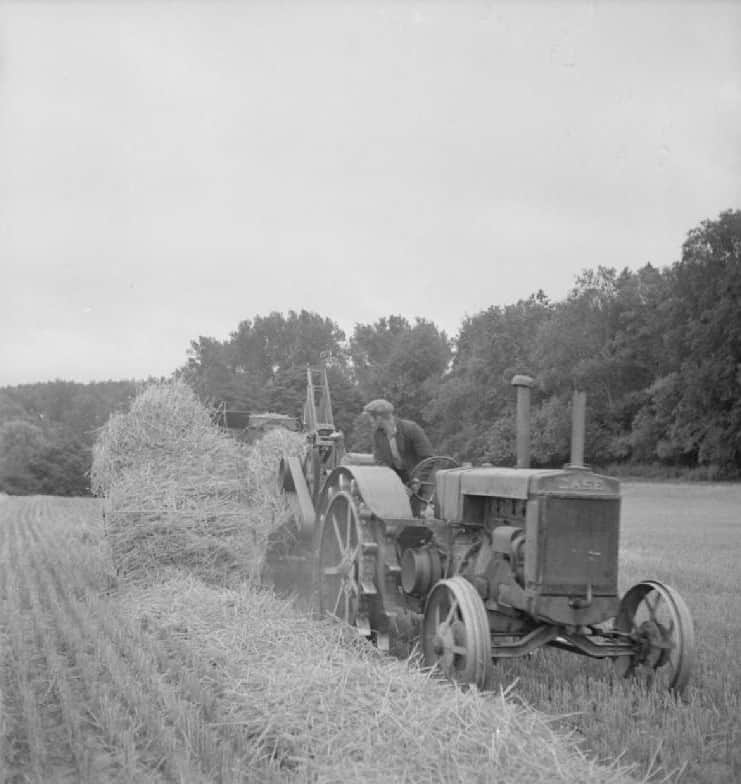
This pick-up baler, circa 1943, was pulled behind a tractor and automatically compressed the bales together.
©Ministry of Information Photo Division Photographer / Public domain – License
Self-tying baling technology was also developed in the 1930s. It was initially developed by an Iowa man named Innes, but it had major design flaws. Edwin Nolt in Pennsylvania engineered a complete redesign of the Innes machine to create the world’s first practical baler that would automatically bind hay bales together with string.

Self-tying baler technology vastly increased hay productivity and efficiency, as seen with this Georgia farmer in 1975.
©National Archives at College Park / Public domain – License
Round Baler
The round baler was conceived by brothers Melchior and Ummo Luebben, although the brothers later had a disagreement and parted ways. In 1910, Ummo Luebben patented a machine that would roll hay into a large, round bale. It would be another 30 years, however, before the Allis-Chalmers Corporation would purchase the patent and begin production of their Roto-Baler. Wesley Buchele in the 1960s and Gary Vermeer in the 1970s made further advances in round baling technology, which led to the modern round baler used on farms worldwide today.
The video below details how a modern round baler works.
What began as a process that was done completely by hand has evolved into a production where hay is baled and stored without ever being touched by a human hand. Who knows what innovations await the next generation of farmers?
Importance of Hay
Most Americans only think of hay when they see hay bales or go on an erroneously-named hayride. But, were it not for hay, many of the foods we take for granted would not be nearly as accessible as they are today. We ought to be thankful for those farmers who mow, rake, and bale the hay that is the foundation for much of our food supply.
The photo featured at the top of this post is © Ken Felepchuk/Shutterstock.com
Thank you for reading! Have some feedback for us? Contact the AZ Animals editorial team.






